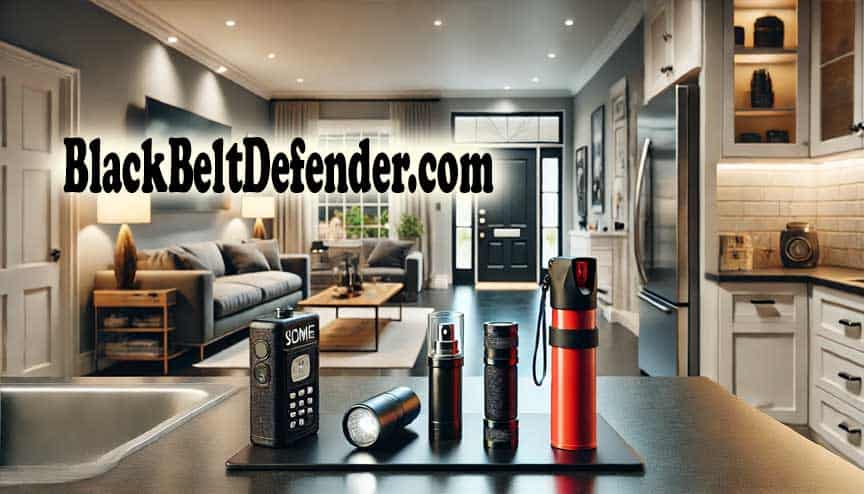
free shipping on orders over $49
We're having a 15% off sale on all our products. Enter your email below to be notified about future sales.




To guarantee your household’s safety, consider equipping your home with effective self-defense tools. Non-lethal options like pepper spray and personal alarms are compact, easy to use, and can incapacitate or deter an attacker. Tactical flashlights can also disorient any potential aggressor. Additionally, everyday items such as pens, scissors, or even a sock filled with coins can serve as improvised defensive tools in urgent situations. For structured practice, run regular safety drills with your family to familiarize everyone with these tools and strategies. There’s more to explore that can further enhance your home’s defense strategy.
To safeguard your home effectively, start by securing all entry points with sturdy locks and deadbolts. This initial step in your home defense strategy is vital. You’re not just locking a door; you’re fortifying your sanctuary against intrusions. Enhance this security by installing window bars on lower and accessible windows. It’s a visible deterrent that tells potential intruders you’re serious about protection.
Next, consider the strategic use of security cameras and motion detectors. These tools aren’t merely reactive; they’re proactive measures that alert you to suspicious activity before it escalates. Place cameras at all entry points and couple them with motion detectors that trigger lights or alarms. This integration can startle an intruder and signal to them that your home is well-defended.
Don’t overlook the importance of strong lighting. Well-lit exteriors provide no shadows for intruders to hide. It’s an effective, simple addition that enhances your other security measures.
As you prioritize your family’s safety, it’s essential to establish emergency plans that everyone understands.
You’ll also want to guarantee that all home access points are secure to prevent unauthorized entry.
Regular safety drills can greatly enhance your family’s readiness and confidence in handling potential emergencies.
Before delving into specific tools, it’s important to establish thorough emergency plans for your family’s safety. Start by designating a safe room that’s stocked with essentials like a phone and first aid supplies. This guarantees you’ve got quick access during any crisis.
Next, set up clear communication protocols. Everyone in your household should know how to contact emergency services effectively. Don’t forget to practice drills regularly. These practices help everyone understand their roles and enhance overall readiness.
Plan multiple escape routes from different areas of your home to make sure you’ve always got options during emergencies. Finally, teach your children how to use emergency numbers and when to call for help, empowering them with crucial self-defense knowledge.
Having established your emergency plans, the next step is securing your home’s access points to further safeguard your family. Here are some essential measures:
These steps not only enhance your personal protection but serve as improvised weapons against breaches. By reinforcing your doors and maintaining a clear, visible environment, you’re setting up a strong defense that makes intruders think twice before attempting to break in.
Regular safety drills guarantee your family is well-prepared and confident in responding to emergencies swiftly and effectively. By simulating scenarios like a home invasion, each member learns their role, ensuring everyone knows how to react.
You’ll establish and reinforce communication protocols, critical when needing to alert law enforcement efficiently. Make sure your safe room is stocked and accessible during these drills. It’s crucial to practice escape routes from different areas of your home, enhancing everyone’s readiness.
Don’t forget to equip each family member with a personal alarm; these small devices can be lifesavers, alerting others even if you’re separated. Regular drills transform initial uncertainty into routine preparedness, making safety second nature.
Why not consider non-lethal defense tools to guarantee your safety without causing permanent harm? As you prioritize safety in your household, it’s important to choose options that are effective yet non-lethal. Pepper spray and personal alarms stand out as top choices due to their ease of use and proven effectiveness.
Pepper spray is a potent tool that can incapacitate an attacker, giving you enough time to escape or seek help. It causes temporary blindness and intense discomfort, ensuring your assailant can’t continue their attack. Personal alarms also play a vital role by emitting a loud sound that can deter an attacker and alert nearby people to your distress. These alarms are particularly useful in urban environments where a quick response from bystanders or law enforcement can be anticipated.
Consider integrating these non-lethal tools into your safety plan:
In times of emergency, everyday household items can transform into effective tools for your defense. You mightn’t realize it, but many objects you use daily can double as improvised defensive items. For instance, a simple pen or scissors from your desk drawer aren’t just for office tasks; they can become potent tools to protect yourself if you’re attacked. Even something as mundane as a stapler can be used to strike at vulnerable points on an attacker.
Consider the weight of a sock filled with pennies; it’s a simple yet significant weapon that can deliver a surprising blow, buying you vital moments to escape. Similarly, that mascara wand in your purse isn’t just for beauty routines—it can act as a sharp, pointed tool in dire situations.
Don’t overlook the kitchen for everyday household objects that can aid in self-defense. A sturdy cutting board can serve as a shield or a striking tool, while vinegar or chili powder can be thrown in an attacker’s eyes to disorient them, allowing you important seconds to flee or call for help.
Leveraging these everyday items can make all the difference when you’re faced with a threat, turning the ordinary into a means of protection.
You should equip your safe room with essentials like a phone, first aid supplies, and emergency contact information to enhance your household’s security during a crisis. Having a designated safe room provides a central spot for your family to converge if an intrusion occurs. This space should be fortified with sturdy locks and reinforced doors to keep everyone secure until help arrives.
Here’s what you need to keep in your safe room:
Establishing communication protocols is vital. Everyone in your household should know how to reach out to emergency responders from the safe room. Regularly practicing these procedures ensures that in the heat of the moment, everyone knows exactly where to go and what to do. Familiarity with the setup and the process can greatly reduce panic and increase the effectiveness of your safe room during emergencies.
After a home invasion, it’s important you contact law enforcement immediately to report the incident and guarantee a professional investigation.
Next, you’ll need to secure your home by fixing any damages and possibly upgrading your security setups to prevent future incidents.
These steps not only restore safety but also help you regain a sense of control over your environment.
Immediately contact law enforcement following a home invasion to report the incident and request assistance. This is one of the vital steps you can take to help you survive and manage the situation effectively. Here’s what you should do:
Taking these actions promptly will greatly assist in the resolution of the incident and help you regain your sense of security.
Once the immediate threat has passed, it’s vital to secure your home to prevent future invasions. First, call the police to report the incident and secure professional help. Don’t forget to seek medical attention, even for minor injuries, as they might worsen over time. It’s also important to repair any physical damage to your home and consider upgrading your security measures.
Here’s a quick guide to help you focus your efforts effectively:
| Action Item | Purpose |
|---|---|
| Repair damaged locks/windows | Prevent unauthorized entry |
| Install new security systems | Enhance overall home protection |
| Seek emotional support | Address psychological impacts |
| Contact insurance | Cover damages and secure finances |
| Update safety plan | Improve future security response |
You’ll want a self-defense weapon that’s legal and effective. Consider firearms for stopping power, or non-lethal options like pepper spray and tasers, ensuring you’re trained to use them effectively in emergencies.
You can use items like cast iron skillets, knives, and even spices as improvised weapons for self-defense. Consider legal considerations and maybe get some improvised weapons training to enhance your skills safely.
The best weapon for your house depends on your comfort and training. Consider weapon storage safety and legal considerations. Firearms, pepper spray, and baseball bats are effective but require responsible handling and familiarity.
You’ll find personal alarms and defense sprays effective for self-defense. Cast iron skillets, knives, spices, vinegar, and cutting boards can also serve as improvised tools to protect yourself in an emergency.
As always, be safe and be prepared.
See Also:
Black Belt Defender
1867 Caravan Trail #105
Jacksonville, FL 32216-2006
Call us toll-free: (800) 859-5566
Mon-Fri: 9:00 am – 5:00 pm EST
NH based, FL Warehouse
Online Orders: 24/7/365

